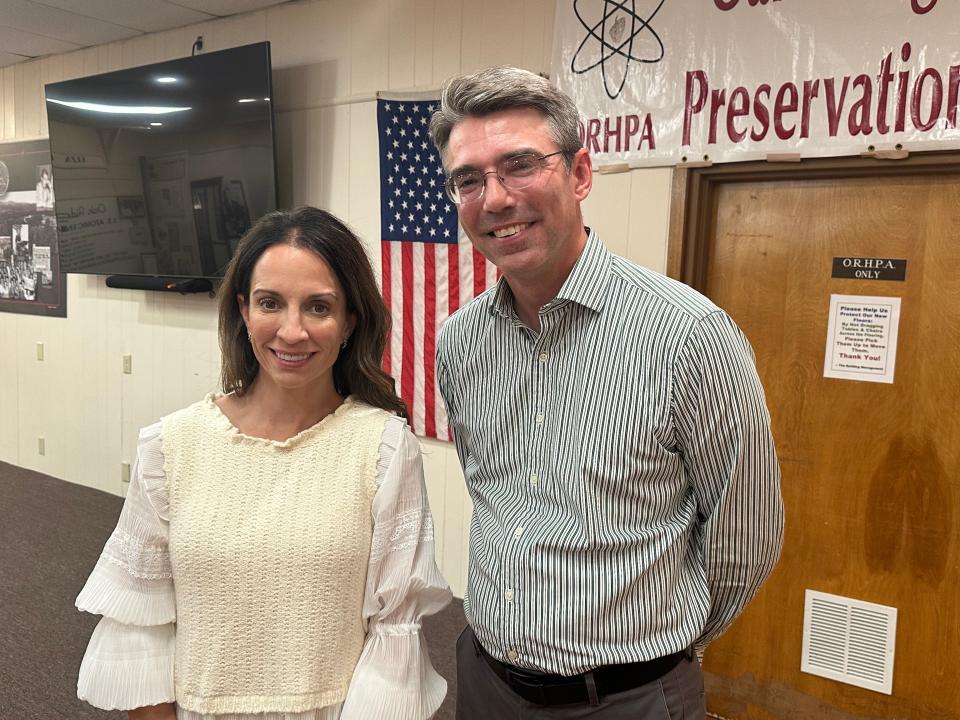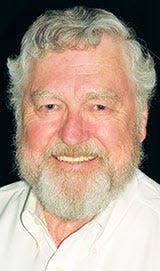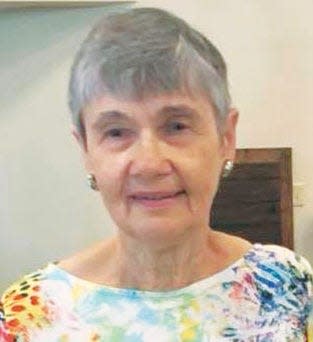Find out more about 'Oppenheimer' - the movie, and the man
- Oops!Something went wrong.Please try again later.
- Oops!Something went wrong.Please try again later.
Thanks to Carolyn Krause for capturing the presentation made at the Oak Ridge History Museum by my friend, Alan Carr, and my new acquaintance, Brye Steeves. I was pleased to help arrange for them to visit Oak Ridge and participate in several events here. This one was hosted by Oak Ridge Heritage & Preservation Association.
***
Interest in J. Robert Oppenheimer persists in Oak Ridge as evidenced by the large turnout at the Oak Ridge History Museum on Oct. 3, to hear Alan Carr, historian for Los Alamos National Laboratory (LANL), and Brye Steeves, director of LANL’s National Security Research Center (NSRC).

Oppenheimer is often known as the father of the atomic bomb, the scientific director of the Manhattan Project, the first director of LANL (first called the Los Alamos Scientific Laboratory) and the topic of the blockbuster 2023 movie “Oppenheimer.” The current director of LANL is Thom Mason, a previous director of Oak Ridge National Laboratory.
One of the messages of the two LANL employees is that last July when Christopher Nolan’s biopic appeared, LANL soon after made available on its website its own documentary produced this year titled, “Oppenheimer: Science-Mission-Legacy” (search on Google for free “LANL Oppenheimer documentary” or use this link: https://discover.lanl.gov/news/0921-oppenheimer-documentary/)
Carr narrates the documentary, which describes Oppie as “a flawed hero.” Among the people who appear in the three-part film on YouTube are Mason; Oppenheimer’s grandson Charles, the family’s unofficial spokesperson; and Jennifer Granholm, secretary of the U.S. Department of Energy, who last December vacated the 1954 revocation of Oppenheimer’s security clearance by DOE’s predecessor, the Atomic Energy Commission – an action asked for by a letter written by Mason and signed by nine other former LANL directors; and Kai Bird, the co-author with the late Martin Sherwin of the 2005 Pulitzer Prize-winning book on which the Nolan movie was based – “American Prometheus: The Triumph and Tragedy of J. Robert Oppenheimer.”
Carr said that the NSRC at Los Alamos was approached by a researcher looking for images of Oppenheimer for possible use in the Nolan movie. Steeves added that since the NSRC she leads has numerous unclassified photos, videos and publications of historic value related to Oppenheimer, Carr, she, and others realized that LANL could make a valuable, informative documentary about its first director that would be available at about the same time as the movie was premiered.
She commented that when Granholm visited Los Alamos to watch a screening of the LANL documentary she is in and to participate in a panel discussion for LANL staff, she said that one purpose of her decision to clear Oppie’s name was that “she wanted to send a very strong message to today’s scientific community that DOE has your back. Her point was that dissent does not mean disloyalty.” (Oppenheimer’s dissent was his opposition to the development of the hydrogen bomb.) Granholm implied that DOE respects and values differences of opinion and questioning attitudes among members of the scientific community, Steeves added.
Carr, who called Oppie a brilliant teacher, ambassador for science and arms control advocate, talked about his interactions with Kai Bird and recommended other books on Oppenheimer, such as “The General and the Genius: Groves and Oppenheimer - The Unlikely Partnership That Built the Atom Bomb” by Carr’s friend James Kunetka; Ray Monk’s “Robert Oppenheimer: A Life Inside the Center,” which digs deeply into Oppie’s past to solve the enigma of his motivations and his complex personality, and “Oppenheimer: Portrait of an Enigma” by Jeremy Bernstein. Carr added that Oak Ridgers might want to read on the internet the transcripts of the 1954 AEC hearings that revoked Oppie’s security clearance. (The full transcript is found here: https://www.osti.gov/opennet/hearing) Carr said the LANL film reports that Oppenheimer was a brilliant scientist who “imported theoretical physics to the United States” and was the first to publish a paper suggesting the existence of “black holes,” which were not discovered until after his death. The announcement of this landmark paper’s publication on Sept. 1, 1939, Carr added, “was overshadowed by the German invasion of Poland on the same day.”
In one of his interactions during a meal with Bird, who he interviewed for the LANL film, Carr learned that Bird was invited by Nolan to watch the filming of one of the scenes at a place close to Los Alamos. (In their “Hidden History” podcast, Bird told hosts Ray Smith and Keith McDaniel that he was somewhat bored by all the takes required to produce an approved piece of film footage.)
Bird also told Carr that since Nolan had bought the rights to use Bird and Sherwin’s book as a basis for the biopic, the movie director asked Bird to “read the script in a hotel room one afternoon and then turn it right back in when he was done,” Carr said. He added that Bird told him that Nolan gave Bird a personal showing of the finished movie at the NBC Universal IMAX theater. Even though the movie has a few historical inaccuracies, largely to increase its entertainment value, Carr said Bird told him that he found it “remarkable to see his book come to life on the big screen,” that he was “moved to tears” by watching the film and that “he embraced Christopher Nolan after seeing the movie.”
Carr also asked Bird at a luncheon about the money he received because of giving Nolan the rights to use “American Prometheus” for the movie, which cost $110 million to make and another $100 million to advertise. Bird said that no more than 6% of the movie budget goes to book authors and that the cap is $500,000. He added that he split his earnings with the estate of his late co-author and that the money he received was taxed.
The LANL historian gave the Nolan movie generally good reviews, especially for the acting and the movie’s ability to hold an audience’s attention despite the numerous characters in it. He stated that the movie had a few historical inaccuracies, that the Einstein character was “a stand-in” for other people not portrayed in the movie and that the “poisoned apple” incident in which a mentally disturbed young Oppenheimer appeared to attempt to murder his mentor at Cambridge University probably never happened (as Charles Oppenheimer asserts).
Carr also said that two people he admired who were somewhat demonized in the movie were Col. Kenneth Nichols (a hero in Oak Ridge, where he became military director of the Manhattan Project’s nuclear fuel facilities after he purchased for the Y-12 plant uranium for electromagnetic separation and silver to replace unavailable copper for the Y-12 magnets), and President Harry Truman, who was offended by Oppie’s tone-deaf comment about having “blood on his hands” when Truman as commander in chief during World War II obviously had a lot more blood on his hands.
In the movie, Carr said, Nichols appeared as a “weasel” when he tried to deny Oppie a security clearance at Los Alamos.
"Nichols, who oversaw Oppie’s background investigation, was rightfully concerned about Oppie’s communist connections,” added Carr, acknowledging that Gen. Leslie Groves made a wise decision appointing Oppie head of the Los Alamos lab even though the brilliant scientist had no management experience.
Oak Ridge Historian D. Ray Smith, in an answer to a question, said that Oppenheimer is known to have visited Oak Ridge twice. One time he visited his brother Frank, who worked at Y-12, and another time government photographer Ed Westcott took an iconic photo of Oppie smoking a cigarette in front of the fireplace mantle at the Guest House, later called the Alexander Inn, and now the Alexander Guest House senior living center (A copy of that iconic photograph is framed and placed on the same mantle shown in the photograph).
Smith added that Oppie’s contributions to Oak Ridge during the Manhattan Project included pushing Groves to get built in three months a third uranium enrichment plant, based on the Navy’s thermal diffusion concept. The three plants (including Y-12 and K-25 gaseous diffusion plants) together produced enough fuel for the first atomic bomb and likely shortened the war by three weeks, Smith said.
Smith added that Oppie may have prevented an explosive criticality accident at Y-12. He sent the famous scientist Richard Feynman (a character in the Nolan movie) to tell Tennessee Eastman and the Army Corps of Engineers how to safely space and geometrically arrange stored drums of uranium nitrate solution to avoid a potentially disastrous release of radioactivity to the Oak Ridge environment.
Carr was asked about the fallout from the Trinity test of a small plutonium bomb in the New Mexico desert, the first detonation of a nuclear weapon (in July 1945), which was designed and built at Los Alamos under Oppie’s leadership. Carr, who has published articles on the test as a historian, cited the findings of health physicists led by Steve Simon with the National Cancer Institute, which are online.
Carr said that they concluded that the radioactivity from the Trinity test “cannot be linked to any particular individual’s cancer” and that it may have caused “500 extra cases of cancer of which about half were thyroid cancers that are typically very treatable.” Carr noted that of the more than half a million people in New Mexico at the time, there were an estimated 188,000 cases of many different types of cancer.
While scientists in Chicago and Oak Ridge signed petitions never sent to President Truman imploring that the first atomic bomb be demonstrated to the Japanese rather than dropped on a populated Japanese city, that was not the case in Los Alamos, Carr said. He noted that Oppie saw “no other possibility other than direct military use of the atomic bomb” and that “he knew it was his duty. He felt that it was the right decision and never regretted using the atomic bomb. He was hopeful at the end of the war that we finally created a weapon that will force people to abandon warfare as a way of resolving their problems.”
One member of the audience, who liked the “Oppenheimer” movie, commented that he thought “it raised the concern about radioactivity that is beyond reason.” Carr agreed with him, noting that sensational articles have been published that assert without proof that the Trinity test injured 100,000 to 500,000 people. He added, “Nobody ever talks about how many hundreds of nuclear power plants are operating safely right now around the world.”
***
Thanks Carolyn! In addition to the excellent presentation covered here, the LANL folks were hosted by the Y-12 National Security Complex with tours and had presentations from LANL for Y-12 employees, as well as Oak Ridge National Laboratory, for tours and a panel discussion for ORNL employees. It was a great week!
The presentation was recorded and can be viewed here: https://youtu.be/EV8f5bSnSIE?si=Kxjw8E0NTEPB7mZr.
The documentary film made by LANL is available here: https://discover.lanl.gov/news/0921-oppenheimer-documentary/.
You can see more of Alan Carr here on Hidden History: Stories from the Secret City: https://www.youtube.com/watch?v=9xz5DVRZlTg&t=2552s.
You can see an interview with Kai Bird, co-author of "The American Prometheus," the book on which the Oppenheimer movie is based, here on "Hidden History: Stories from the Secret City" at https://www.youtube.com/watch?v=sRTHDriQ5ZI&t=92s.
And if you have not seen the movie Oppenheimer, go see it!
D. Ray Smith is the city of Oak Ridge historian and his column "Historically Speaking" appears weekly in The Oak Ridger. Carolyn Krause is a frequent contributor to "Historically Speaking" and The Oak Ridger. She is the former editor of the ORNL Review.


This article originally appeared on Oakridger: Oak Ridgers learn more about 'Oppenheimer' - the movie and the man

